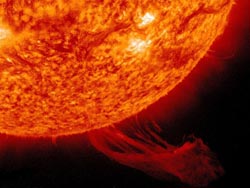UI-led team confirms 'gusty winds' in space turbulence

A solar prominence erupts into the sun's atmosphere, or corona. Image courtesy of NASA.<br>
Imagine riding in an airplane as the plane is jolted back and forth by gusts of wind that you can’t prove exist but are there nonetheless.
Similar turbulence exists in space, and a research team led by the University of Iowa reports to have directly measured it for the first time in the laboratory.
“Turbulence is not restricted to environments here on Earth, but also arises pervasively throughout the solar system and beyond, driving chaotic motions in the ionized gas, or plasma, that fills the universe,” says Gregory Howes, assistant professor of physics and astronomy at the UI and lead author of the paper to be published Dec. 17 in the online edition of Physical Review Letters, the journal of the American Physical Society. “It is thought to play a key role in heating the atmosphere of the sun, the solar corona, to temperatures of a million degrees Celsius, nearly a thousand times hotter than the surface of the sun.”
Researchers at the University of Iowa and UCLA have measured space turbulence for the first time in a laboratory. The animation shows these bursts of turbulence, with the brighter colors (yellow, red) indicating increased turbulence. Credit: James Schoeder and Basic Plasma Science Facility, UCLA.
He adds: “Turbulence also regulates the formation of the stars throughout the galaxy, determines the radiation emitted from the super massive black hole at the center of our galaxy and mediates the effects that space weather has on the Earth.“
One well known source of gusty space winds are the violent emissions of charged particles from the sun, known as coronal mass ejections. These solar-powered winds can adversely affect satellite communications, air travel and the electric power grid. On the positive side, solar storms also can also lead to mesmerizing auroras at the north and south poles on Earth.
Howes notes that unlike gusts of wind on the surface of the Earth, turbulent motions in space and astrophysical systems are governed by Alfven waves, which are traveling disturbances of the plasma and magnetic field. Nonlinear interactions between Alfven waves traveling up and down the magnetic field—such as two magnetic waves colliding to create a third wave—are a fundamental building block of plasma turbulence, and modern theories of astrophysical turbulence are based on this underlying concept, he says.
“We have presented the first experimental measurement in a laboratory plasma of the nonlinear interaction between counter-propagating Alfven waves, the fundamental building block of astrophysical turbulence,” Howes says.
Contributing authors on the paper are D.J. Drake, K.D. Nielson, Craig Kletzing, and Fred Skiff, all of the University of Iowa, and T.A. Carter of the University of California, Los Angeles. The research, conducted at the Large Plasma Device at UCLA, was funded by a grant from the NSF/DOE Partnership in Basic Plasma Science and Engineering.
Preprints of the abstract and paper, “Toward Astrophysical Turbulence in the Laboratory,” (PDF download) are available at: http://lanl.arxiv.org/abs/1210.4568
Howes is a 2010 Presidential Early Career Awards for Scientists and Engineers recipient. In 2011, he won a five-year Faculty Early Career Development Award from the NSF to study the near-Earth solar wind.
Contacts
Gary Galuzzo, University Communication and Marketing, 319-384-0009
Gregory Howes, Physics and Astronomy, 510-295-8242
Media Contact
More Information:
http://www.uiowa.eduAll latest news from the category: Physics and Astronomy
This area deals with the fundamental laws and building blocks of nature and how they interact, the properties and the behavior of matter, and research into space and time and their structures.
innovations-report provides in-depth reports and articles on subjects such as astrophysics, laser technologies, nuclear, quantum, particle and solid-state physics, nanotechnologies, planetary research and findings (Mars, Venus) and developments related to the Hubble Telescope.
Newest articles

Superradiant atoms could push the boundaries of how precisely time can be measured
Superradiant atoms can help us measure time more precisely than ever. In a new study, researchers from the University of Copenhagen present a new method for measuring the time interval,…

Ion thermoelectric conversion devices for near room temperature
The electrode sheet of the thermoelectric device consists of ionic hydrogel, which is sandwiched between the electrodes to form, and the Prussian blue on the electrode undergoes a redox reaction…

Zap Energy achieves 37-million-degree temperatures in a compact device
New publication reports record electron temperatures for a small-scale, sheared-flow-stabilized Z-pinch fusion device. In the nine decades since humans first produced fusion reactions, only a few fusion technologies have demonstrated…





















